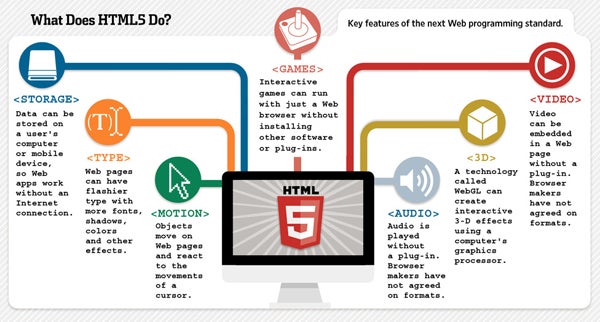HTML 5: A closer look at the technology that will replace Flash

In the wake of Adobe ending development of Flash for mobiledevices, the launch pad has been cleared for HTML 5 to take off and change theweb forever. HTML 5, the fifth incarnation of the hypertext markup languageused to drive websites, allows web developers to create “app-like” experiencesthat work in most modern browsers without any plugins.
In the past, websites that wanted media-rich interactivecontent had to rely upon Adobe’s Flash or other browser add-ons.The technology was developed for desktopcomputers, and in April of 2011 Steve Jobs famously penned an essay condemningthe use of Flash on mobile devices, and popular Apple mobile products like theiPad and iPhone have continued to eschew Flash.
Adobe made great strides with the mobile version of FlashPlayer, and modern dual-core smartphones like the Samsung Galaxy S II provideexcellent Flash experience for mobile web-surfing. Unfortunately for Adobe, thepopularity of iOS products meant they had to find a way to support thoseplatforms, or risk losing developers who want to create cross-platform content.
HTML 5 was the solution – it will workon any device with a modern browser. As a result, Adobe built HTML 5 supportinto its content creation software. While yhismeans that Adobe developers can now export apps and interactive websites to allmobile platforms, it also meant that the money Adobe invested intomobile Flash was redundant, as Android and Blackberry handsetssupport HTML 5 just as effectively as they do Flash.
It’s important to note that HTML 5 standard isn’t finishedyet. It has been under development since 2004, but the World Wide WebConsortium (W3C) has yet to finalize it, and it’s thought that HTML 5 won’t seeit’s official incarnation until 2012. Despite its unfinished status, HTML 5 hasseen widespread adoption across the web. A recent survey reported in The WallStreet Journal shows that 34 of the top 100 most popular websites use HTML 5.
It’s likely that the average user won’t even realize there’sa difference between HTML 5 and Flash – and that’s exactly how developers wantit. The point is to make interactive experiences on the web that will rivalwhat is seen in apps. End users just want good content; they don’t really carehow it’s delivered to them.
Now that Adobe has committed to HTML 5, we will probably seean acceleration of their efforts to promote HTML 5 creation tools, which canonly aid the forward march of HTML 5 as it transforms the web as we know it.

source: WSJ












Things that are NOT allowed: